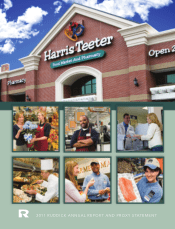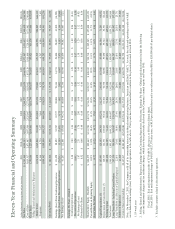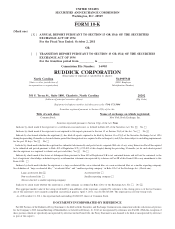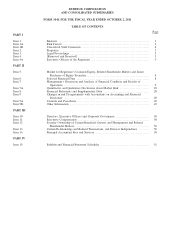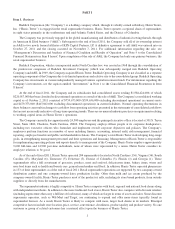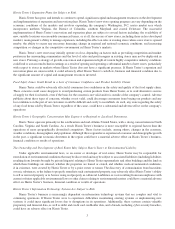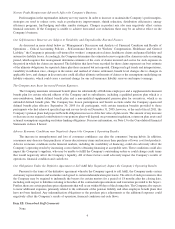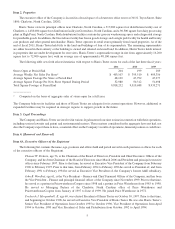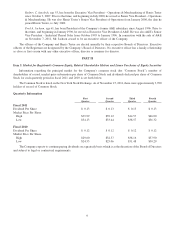Harris Teeter 2011 Annual Report Download - page 5
Download and view the complete annual report
Please find page 5 of the 2011 Harris Teeter annual report below. You can navigate through the pages in the report by either clicking on the pages listed below, or by using the keyword search tool below to find specific information within the annual report.PART I
Item 1. Business
Ruddick Corporation (the “Company”) is a holding company which, through its wholly-owned subsidiary, Harris Teeter,
Inc. (“Harris Teeter”) is engaged in the retail supermarket business. Harris Teeter operates a regional chain of supermarkets
in eight states primarily in the southeastern and mid-Atlantic United States, and the District of Columbia.
The Company was previously engaged in the global manufacturing and distribution of industrial sewing threads, through
its American & Efird business (“A&E”). Subsequent to the end of fiscal 2011, the Company sold all of its ownership interest
in A&E to two newly formed affiliates of KPS Capital Partners, LP. A definitive agreement to sell A&E was entered into on
October 27, 2011 and the closing occurred on November 7, 2011. For additional information regarding the sale, see
“Management’s Discussion and Analysis of Financial Condition and Results of Operation” and Note 5 to the Consolidated
Financial Statements in Item 8 hereof. Upon completion of the sale of A&E, the Company had only one primary business, the
retail supermarket business.
Ruddick Corporation, which is incorporated under North Carolina law, was created in 1968 through the consolidation of
the predecessor companies of Ruddick Investment Company (which was subsequently merged into Ruddick Operating
Company) and A&E. In 1969, the Company acquired Harris Teeter. Ruddick Operating Company is not classified as a separate
operating component of the Company due to its limited operations and relative size to the consolidated group. Ruddick Operating
Company has investments in various independently managed venture capital investment funds. For information regarding the
Company’s investments, see the caption entitled “Investments” in Note 1 to the Consolidated Financial Statements in Item
8 hereof.
At the end of fiscal 2011, the Company and its subsidiaries had consolidated assets totaling $1,984,424,000, of which
$220,017,000 has been classified as discontinued operations as a result of the sale of A&E. The Company’s consolidated working
capital as of October 2, 2011 consisted of $759,673,000 ($539,656,000 excluding discontinued operations) in current assets
and $479,373,000 ($407,802,000 excluding discontinued operations) in current liabilities. Normal operating fluctuations in
these balances can result in changes to cash flow from operating activities presented in the statements of consolidated cash flows
that are not necessarily indicative of long-term operating trends. There are no unusual industry practices or requirements relating
to working capital items in Harris Teeter’s operations.
The Company currently has approximately 24,500 employees and the principal executive office is located at 301 S. Tryon
Street, Suite 1800, Charlotte, North Carolina, 28202. The Company employs fifteen people at its corporate headquarters,
including two executive officers who formulate and implement overall corporate objectives and policies. The Company’s
employees perform functions in a number of areas including finance, accounting, internal audit, risk management, financial
reporting, employee benefits and public and shareholder relations. The Company assists Harris Teeter in developing long-range
goals, in strengthening management personnel and their operations and financing. Management at Harris Teeter is responsible
for implementing operating policies and reports directly to management of the Company. Harris Teeter employs approximately
9,600 full-time and 14,900 part-time individuals, none of whom were represented by a union. Harris Teeter considers its
employee relations to be good.
As of the end of fiscal 2011, Harris Teeter operated 204 supermarkets located in North Carolina (136), Virginia (36), South
Carolina (13), Maryland (6), Tennessee (5), Delaware (3), District of Columbia (3), Florida (1) and Georgia (1). These
supermarkets offer a full assortment of groceries, produce, meat and seafood, delicatessen items, bakery items, wines and
non-food items such as health and beauty care, general merchandise and floral. In addition, Harris Teeter operated pharmacies
in 133 of their supermarkets as of the end of fiscal 2011. Retail supermarket operations are supported by two company-owned
distribution centers and one company-owned dairy production facility. Other than milk and ice cream produced by the
company-owned facility, Harris Teeter purchases most of the products it sells, including its store brand products, from outside
suppliers or directly from the manufacturers.
The supermarket industry is highly competitive. Harris Teeter competes with local, regional and national food chains along
with independent merchants. In addition to the more traditional food stores, Harris Teeter also competes with discount retailers
(including supercenters that carry a full line of food items), many of which are larger in terms of assets and sales. Some discount
supercenter operators, such as Wal-Mart and Target, are continuing to expand and offer more items typically found in
supermarket formats. As a result, Harris Teeter is likely to compete with more, larger food chains in its markets. Principal
competitive factors include store location, price, service, convenience, cleanliness, product quality and product variety. No one
customer or group of related customers has a material effect upon the business of Harris Teeter.
1

